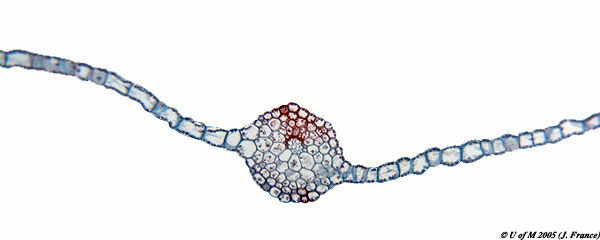
 |

A thallus is a multicellular plant body exhibiting little differentiation of tissues and lacking such organs as roots, stems and leaves. The thallus is derived from cell divisions occurring in more than two planes. This results in a fairly complex three dimensional plant body that varies in thickness and in shape. Many aquatic algae have attained this level of cellular organization including some members of the Chlorophyta, Phaeophyta and Rhodophyta. Unfortunately time does not permit a detailed study of these organisms in this course.
We will be studying representatives of a group of land plants that exhibit a thalloid level of cellular organization, the mosses. Mosses belong to the division Bryophyta (Canadian Campbell 2nd ed. Concept 29.2). The life cycle of a bryophyte involves the alternation of two multicellular generations, the gametophyte (haploid, gamete producing phase) and the sporophyte (diploid, spore producing phase). In bryophytes, the gametophyte is the dominant and persistent phase in the life cycle. The sporophyte is reduced and short lived. It functions in the production of spores by meiosis and then degenerates.
Mosses
(Canadian Campbell 2nd ed. Concept 29.2)
The gametophyte thallus of a moss plant is composed of an erect to prostrate "stem" bearing spirally arranged "leaves". Though morphologically similar in external appearance, these structures ARE NOT the same as the highly differentiated true leaves and stems of vascular plants. The moss thallus (the gametophyte phase) is a perennial plant with new tissue being added on a yearly basis. Growth of the moss thallus is from repeated mitotic divisions of a single pyramid-shaped cell located at the apex of the thallus. Older basal portions of the thallus progressively die and decompose. The decomposing thallus of the genus Sphagnum can in some instances be several meters thick forming an organic soil material termed peat moss.
View a summary of the moss life cycle
The "leaf-like" segments in the majority of mosses are composed of a uniseriate layer (single layer) of cells that are rich in chloroplasts. A cuticle is lacking with the diffusion of gases (eg. CO2 for photosynthesis), water and dissolved minerals occurring across the entire surface of the thallus. Rhizoids are often located at the base of the thallus.
Most bryophytes are dioecious, referring to the fact that the antheridia (male gametangia) and archegonia (female gametangia) are produced on separate plants.
Examine the distinctive variation between male and female Polytrichum
Examine the preserved male gametophytes of Polytrichum (Note the cup-shaped whorl of appendages at the apex of the male thallus)
Examine a live group of male gametophytes
Antheridia are located at the apex of the male gametophyte thallus.
View the Antheridia with high magnification
(Note the antheridia consisting of a uniseriate layer of jacket cells,
a short stalk and a mass of protoplasm that will eventually differentiate
into the flagellated sperm cells)
Examine the preserved female gametophytes of Polytrichum. The leaf-like appendages at the apex of the thallus are elongated and function in trapping sperm containing water transferred from the male gametophyte by the "splash technique".
Archegonia are located at the apex of the female gametophyte thallus.
Examine a live female Gametophyte group.
View the Archegonia with high magnification
(Note the archegonia consisting of a swollen venter
containing the large egg cell and an elongated neck canal leading to the egg)
The sperm are transferred to the archegonium in a water medium by means of a "splash technique". When mature, the sperm cells are discharged into films of water on the surface of the apical cup which acts as a splash platform. Subsequent water droplets falling on the cup surface cause a splashing of water drops containing the motile sperm cells. If a female gametophyte is growing nearby, one of these drops may adhere to the elongated leaf-like appendages at the apex of the female thallus. The sperm swim up the neck canal of the archegonium, the sperm and egg fuse and a diploid zygote is formed.
The zygote is the first cell of the new sporophyte generation. The zygote divides by mitosis into a multicellular embryo phase within the archegonium. This embryo continues development into a mature sporophyte consisting of a foot, stalk (seta) and sporangium (capsule). Within the sporangium, special cells called sporocytes divide by meiosis to produce thick-walled haploid spores.
Examine the preserved sporophyte of Polytrichum attached to the apex of a gametophyte thallus and note the stalk and sporangium of the moss sporophyte.
Examine a live female gametophyte with attached sporophyte
Examine a longitudinal section of a moss sporangium (capsule). Thick-walled spores are located within the loculi of the sporangium.
Click Here to View a Summary of the Moss Life Cycle
![]()
